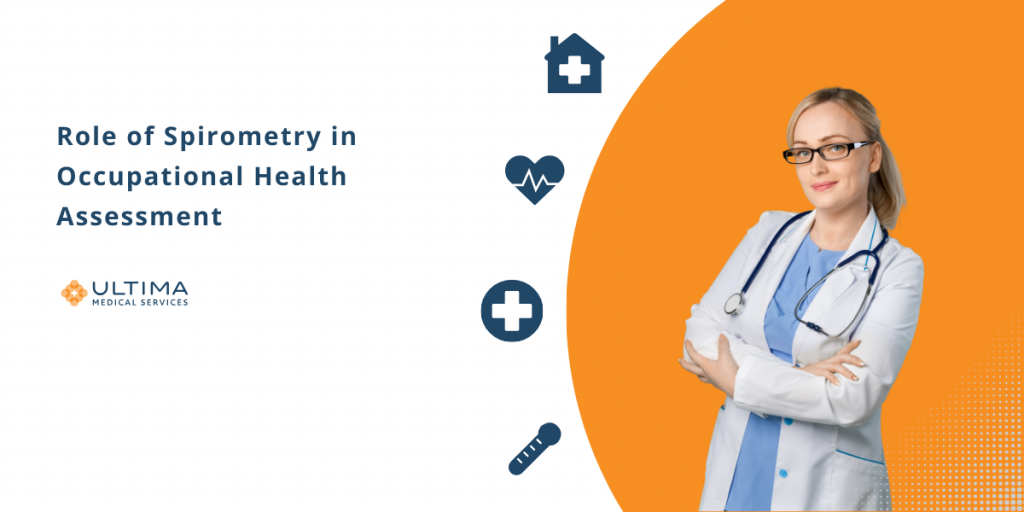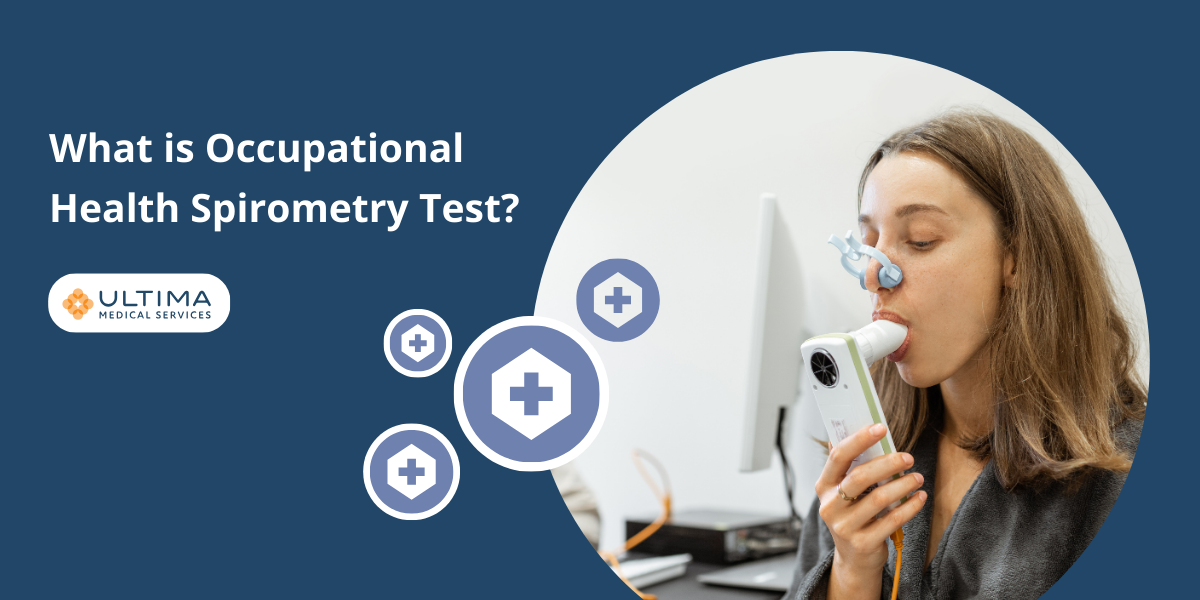Occupational health is paramount in ensuring the well-being of employees exposed to various workplace hazards. One crucial aspect of occupational health management is Spirometry Test, a diagnostic procedure that evaluates lung function. In this blog, we delve into the significance of spirometry testing in occupational health, exploring its role, benefits, and the services provided by Ultima Medical in British Columbia, Canada.
What is a Spirometry Test?
A Spirometry Test is a diagnostic procedure used to assess lung function and respiratory health. During the test, a person breathes into a device called a spirometer, which measures the volume and speed of air that is inhaled and exhaled. This information helps healthcare providers evaluate lung capacity, airflow rates, and the overall functionality of the respiratory system. The spirometry test can measure several key parameters, including:
- Forced Vital Capacity (FVC): The maximum amount of air a person can exhale forcefully after taking a deep breath.
- Forced Expiratory Volume in one second (FEV1): The volume of air exhaled in the first second of the forced breath.
- FEV1/FVC Ratio: The ratio of FEV1 to FVC, which helps assess airway obstruction.
These measurements provide valuable insights into lung function and can help diagnose various respiratory conditions such as asthma, chronic obstructive pulmonary disease (COPD), restrictive lung diseases, and more. Overall, spirometry testing is a valuable tool in evaluating respiratory health, diagnosing lung disorders, monitoring disease progression, and guiding treatment decisions.
Importance of Occupational Health Spirometry Testing
Occupational Health Spirometry Testing plays a crucial role in ensuring the well-being of workers exposed to occupational hazards. Here are several key reasons why spirometry testing is important in occupational health:
Early Detection of Respiratory Impairments
Spirometry testing helps detect early signs of respiratory impairments, such as reduced lung function or abnormalities in airflow. Early detection allows for prompt intervention and management of respiratory conditions, preventing them from progressing into more severe health issues.
Prevention of Advanced Occupational Lung Diseases
By monitoring lung function regularly through spirometry testing, occupational health programs can prevent the development of advanced occupational lung diseases. Detecting lung impairments early allows for targeted interventions, lifestyle modifications, and appropriate medical treatments to manage and mitigate the risks associated with occupational exposures.
Promoting a Safer Work Environment
Implementing spirometry testing as part of occupational health programs promotes a safer work environment by identifying and addressing respiratory hazards effectively. It enables employers to take proactive measures to reduce exposure to harmful substances, implement engineering controls, provide personal protective equipment (PPE), and educate employees on respiratory health and safety practices.
Guiding Workplace Health Monitoring Programs
Spirometry testing provides valuable data for establishing baseline lung function measurements and monitoring changes over time. This information is essential for developing and refining workplace health monitoring programs tailored to specific occupational hazards and employee health needs. Regular spirometry testing helps track the effectiveness of interventions, assess occupational exposures, and ensure compliance with regulatory standards.
Improving Employee Health Outcomes
By proactively managing respiratory health through spirometry testing, organizations can improve employee health outcomes and quality of life. Early identification and management of respiratory conditions lead to better disease management, reduced absenteeism, improved productivity, and enhanced overall well-being among employees.
Compliance with Regulatory Requirements
Many regulatory bodies and occupational health standards require regular monitoring of respiratory health in high-risk industries. Spirometry testing helps organizations comply with these regulations, maintain a safe working environment, and demonstrate a commitment to employee health and safety.
Common Occupational Lung Diseases
Several occupational lung diseases can result from exposure to various workplace hazards. Here are some of the most common occupational lung diseases:
Chronic Obstructive Pulmonary Disease (COPD)
COPD is a progressive lung disease that includes conditions such as chronic bronchitis and emphysema. Prolonged exposure to irritants like tobacco smoke, air pollution, dust, and chemicals in the workplace can lead to COPD. Symptoms include difficulty breathing, coughing, wheezing, and chest tightness.
Occupational Asthma
Occupational asthma is caused by exposure to allergens or irritants in the workplace, such as dust, fumes, chemicals, and animal dander. It can develop or worsen due to workplace exposures, leading to asthma symptoms like wheezing, coughing, chest tightness, and shortness of breath.
Pneumoconiosis
Pneumoconiosis refers to lung diseases caused by the inhalation of mineral dust particles, such as silica, coal dust, asbestos fibers, and other hazardous substances. Common types of pneumoconiosis include silicosis, coal workers’ pneumoconiosis (black lung disease), and asbestosis. These conditions can cause lung scarring, fibrosis, and respiratory impairment.
Lung Cancer
Occupational exposure to carcinogens like asbestos, radon, diesel exhaust, and certain chemicals increases the risk of developing lung cancer. Workers in industries such as mining, construction, manufacturing, and transportation are at higher risk. Lung cancer symptoms may include persistent cough, chest pain, hoarseness, weight loss, and difficulty breathing.
Respiratory Tuberculosis
Tuberculosis (TB) is a bacterial infection that primarily affects the lungs. Occupational exposure to TB in healthcare settings, laboratories, and other high-risk environments can lead to respiratory TB. Symptoms include coughing, chest pain, fatigue, fever, night sweats, and weight loss.
Malignant Mesothelioma
Mesothelioma is a rare but aggressive cancer that affects the lining of the lungs (pleural mesothelioma), abdomen, heart, or testicles. It is primarily caused by exposure to asbestos fibers in workplaces such as construction, shipbuilding, and asbestos mining. Symptoms include chest pain, difficulty breathing, coughing, and unexplained weight loss.
Pneumonia
Occupational exposure to respiratory pathogens, such as bacteria, viruses, and fungi, can increase the risk of developing pneumonia. Healthcare workers, agricultural workers, and individuals exposed to contaminated air or water in certain industries are at higher risk. Pneumonia symptoms include fever, chills, cough, chest pain, and difficulty breathing.

Role of Spirometry in Occupational Health
The role of spirometry in occupational health is multifaceted and crucial for ensuring the respiratory well-being of workers exposed to occupational hazards. Here are the key roles of spirometry in occupational health:
Screening and Monitoring Lung Function
Spirometry serves as a valuable screening tool for assessing baseline lung function in employees entering the workforce. It establishes a reference point for monitoring changes in lung function over time, especially in workers exposed to respiratory hazards. Regular spirometry testing allows for the early detection of abnormalities or declines in lung function, enabling prompt intervention and preventive measures.
Detecting Respiratory Abnormalities
Spirometry testing provides comprehensive assessments of lung function, including vital capacity, forced vital capacity (FVC), forced expiratory volume in one second (FEV1), and FEV1/FVC ratio. These measurements help detect various respiratory abnormalities, such as obstructive lung diseases like asthma and chronic obstructive pulmonary disease (COPD), as well as restrictive lung diseases and other impairments. Early detection of these abnormalities is crucial for managing respiratory conditions effectively and preventing disease progression.
Assessing the Impact of Occupational Exposures
Spirometry testing plays a pivotal role in assessing the impact of occupational exposures to respiratory hazards, such as dust, chemicals, fumes, and allergens. By comparing spirometry results with exposure histories and occupational risk assessments, healthcare providers and occupational health professionals can identify relationships between workplace exposures and respiratory health outcomes. This information guides targeted interventions, exposure control measures, and health monitoring programs to mitigate risks and protect workers’ respiratory health.
Guiding Health Surveillance Programs
Spirometry testing is an essential component of health surveillance programs in high-risk industries and occupations. Regulatory standards and occupational health guidelines often mandate regular spirometry testing for workers exposed to respiratory hazards. These programs aim to monitor lung function, detect early signs of respiratory impairment, ensure compliance with health and safety regulations, and promote a culture of occupational health and well-being in the workplace.
Facilitating Medical Fitness Assessments
Spirometry testing is integral to medical fitness assessments for employees in safety-sensitive roles or jobs with respiratory exposure risks. It helps determine an individual’s ability to perform job duties safely, considering their respiratory health status and any potential limitations or restrictions. This information assists employers in making informed decisions regarding workplace assignments, accommodations, and health plans for employees with respiratory conditions.
Ultima Medical Provides Occupational Health Spirometry Test in BC
Ultima Medical is a trusted provider of occupational health spirometry testing in British Columbia (BC), Canada. Accredited by the BC College of Physicians & Surgeons Diagnostic Accreditation Program (DAP), Ultima Medical offers reliable spirometry services tailored to the unique needs of workplaces and employees in BC. Occupational Health Spirometry Test at Ultima Medical encompasses a comprehensive approach to respiratory health management in occupational settings.
Occupational health spirometry testing is a crucial component of workplace health and safety initiatives. By prioritizing respiratory health through regular testing and monitoring, organizations can mitigate risks, protect employees, and foster a healthier work environment. Ultima Medical’s expertise in spirometry testing makes it a valuable partner in promoting occupational health and well-being.


